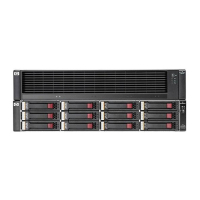Figure 3 SAS LFF disk drive numbering
.
Types of disk failures
There are two types of disk failures:
• Hard failure: The disk is no longer functioning properly and has been
assigned a failed status. This type of failure is indicated by an oper-
ational state of (Failed) in HP P6000 Command View. The amber
fault status indicator on the disk is typically on.
• Impending failure: Although the disk is still functioning, errors have
been detected that indicate an impending failure. This type of failure
is not accompanied by a failed status.
CAUTION:
A disk with an impending failure will appear to be
operating normally in HP P6000 Command View,
and the fault light on the disk will not be on.
Therefore, it is important that you positively identify
the disk before performing the replacement. Work
with the HP Solution Center to ensure you identify
the correct disk for replacement.
Checking system redundancy
Before replacing a disk, check the redundancy status of the entire storage
system to ensure a disk can be removed without impacting data
availability.
1. Open HP P6000 Command View and click the icon of the storage
system you want to check (Figure 4).
Figure 4 Selecting a storage system
.
2. On the Initialized Storage System Properties window, click Check
Redundancy (Figure 5).
Figure 5 Checking redundancy
.
3. If the system is redundant, continue with Verifying component failure.
If the system is not redundant, information is displayed indicating
the cause of the lack of redundancy. See the HP P6000 Command
View online help to interpret the information that is displayed. In
this situation, work with your HP call center agent to determine how
to proceed.
CAUTION:
Do not proceed with the disk replacement until you are certain
the storage system is redundant.
Verifying component failure
Before replacing a disk, use the following methods to verify component
failure:
CAUTION:
If HP P6000 Command View does not present a status consistent
with the disk status indicators, or if HP P6000 Command View
or your system monitoring tool indicates multiple hardware
failures, contact HP support for assistance (http://www.hp.com/
support).
• Analyze any failure messages received. Error messages identify each
disk by its rack, enclosure, bay, and UUID (World Wide Name).
Record this information to assist you in identifying the correct disk
before replacing it.
The following is a sample of the disk identification information:
FRU List:
Storage System Name: EVA_1
Storage System World Wide ID: 5000-1FE1-0015-42A0
Disk Drive UUID: 2000-0000-871D-FE60
Drive Location ---
Enclosure ID: 8
Bay ID: 1
Rack Number: 0
NOTE:
The Disk Drive UUID corresponds to the disk Node
World Wide Name displayed in HP P6000
Command View.
• Check the disk status indicators (Figure 6 for Fibre Channel disks
and Figure 7 for SAS disks; Table 1 describes the LEDs). If a hard
failure has occurred, the amber indicator should be on solid.
Page 2

